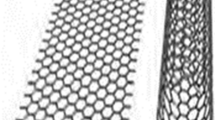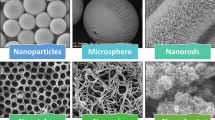Abstract
Luminescent silica nanotubes and nanowires were fabricated from cellulose whisker templates by sol-gel processing. The cellulose templates were removed by calcination at 650 °C to generate silica nanotubes with diameters of 15 nm and lengths up to 500 nm. At temperatures of 900 °C the core region previously occupied by the cellulose template was closed yielding silica nanowires. Cathodoluminescence spectra of the silica nanotubes and nanowires were measured in the transmission electron microscope during irradiation with 150 keV electrons. A blue emission at 450 nm was observed for the silica nanowires calcined at 900 °C. This luminescence was found to be related to defects induced by electron irradiation and was investigated in situ as a function of irradiation dose. The as-synthesized and 650 °C calcined nanowires and nanotubes showed a fast decay of the signal. The observed irradiation dose dependent changes in the luminescence spectra will be discussed in terms of defect formation and transformation mechanisms.
Similar content being viewed by others
References
G.R. Patzke, F. Krumeich, and R. Nesper: Oxidic nanotubes and nanorods-Anisotropic modules for a future nanotechnology. Angew. Chem. Int. Ed. 41, 2446 (2002).
L. Tong, R.R. Gattass, J.B. Ashcom, S. He, J. Lou, M. Shen, I. Maxwell, and E. Mazur: Subwavelength-diameter silica wires for low-loss optical wave guiding. Nature 426, 816 (2003).
Y. Zhang, K. Suenaga, C. Colliex, and S. Iijima: Coaxial nanocable: Silicon carbide and silicon oxide sheathed with boron nitride and carbon. Science 281, 973 (1998).
D.T. Mitchell, S.B. Lee, L. Trofin, N. Li, T.K. Nevanen, H. Soderlund, and C.R. Martin: Smart nanotubes for bioseparation and biocatalysis. J. Am. Chem. Soc. 124, 11864 (2002).
B. He, S.J. Son, and S.B. Lee: Shape-coded silica nanotubes for biosensing. Langmuir 22, 8263 (2006).
D.P. Yu, Q.L. Hang, Y. Ding, H.Z. Zhang, Z.G. Bai, J.J. Wang, Y.H. Zou, W. Quian, G.C. Xiong, and S.Q. Feng: Amorphous silica nanowires: Intensive blue light emitters. Appl. Phys. Lett. 73, 3076 (1998).
X.C. Wu, W.H. Song, K.Y. Wang, T. Hu, B. Zhao, Y.P. Sun, and J.J. Du: Preparation and photoluminescence properties of amorphous silica nanowires. Chem. Phys. Lett. 336, 53 (2001).
J. Jang and H. Yoon: Novel fabrication of size-tunable silica nanotubes using a reverse-microemulsion-mediated sol-gel method. Adv. Mater. 16, 799 (2004).
H.J. Chang, Y.F. Chen, H.P. Lin, and C.Y. Mou: Strong visible photoluminescence from SiO2 nanotubes at room temperature. Appl. Phys. Lett. 78, 3791 (2001).
M. Zhang, E. Ciocan, Y. Bando, K. Wada, L.L. Cheng, and P. Pirouz: Bright visible photoluminescence from silica nanotube flakes prepared by the sol-gel template method. Appl. Phys. Lett. 80, 491 (2002).
H. Nishikawa, T. Shiroyama, R. Nakamura, Y. Ohki, K. Nagasawa, and Y. Hama: Photoluminescence from defect centers in high-purity silica glasses observed under 7.9-eV excitation. Phys. Rev. B 45, 586 (1992).
L.S. Liao, X.M. Bao, X.Q. Zheng, N.S. Li, and N.B. Min: Blue luminescence from Si+-implanted SiO2 films thermally grown on crystalline silicon. Appl. Phys. Lett. 68, 850 (1996).
J.H. Stathis and M.A. Kastner: Time-resolved photoluminescence in amorphous silicon dioxide. Phys. Rev. B 35, 2972 (1987).
L. Skuja: Optically active oxygen-deficiency-related centers in amorphous silicon dioxide. J. Non-Cryst. Solids 16, 239 (1998).
R. Tohmon, Y. Shimogaichi, H. Mizuno, and Y. Ohki: 2.7 eV luminescence in as-manufactured high-purity silica glass. Phys. Rev. Lett. 62, 1388 (1989).
L.N. Skuja, A.N. Streletsky, and A.B. Pakovich: A new intrinsic defect in amorphous SiO2: Twofold coordinated silicon. Solid State Commun. 50, 1069 (1984).
K. Tanimura, C. Itoh, and N. Itoh: Optical studies of self-trapped excitons in SiO2. J. Phys. C: Solid State Phys. 21, 1869 (1988).
S.W. McKnight and E.D. Palik: Cathodoluminescence of SiO2 films. J. Non-Cryst. Solids 40, 595 (1980).
K. Tanimura, K. Tanaka, and N. Itoh: Creation of quasistable lattice defects by electronic excitation in SiO2. Phys. Rev. Lett. 51, 423 (1983).
A.J. Miller, R.G. Leisure, V.A. Mashkov, and F.L. Galeener: Dominant role of E’ centers in x-ray-induced, visible luminescence in high-purity amorphous silicas. Phys. Rev. B 53, R8818 (1996).
H. Imai, K. Arai, H. Imagawa, H. Hosono, and Y. Abe: Two types of oxygen-deficient centers in synthetic silica glass. Phys. Rev. B 38, 12772 (1988).
T.E. Tsai, D.L. Griscom, and E.J. Friebele: Mechanism of intrinsic Si E’-center photogeneration in high-purity silica. Phys. Rev. Lett. 61, 444 (1988).
M. Watanabe, S. Juodkazis, H.B. Sun, S. Matsuo, and H. Misawa: Luminescence and defect formation by visible and near-infrared irradiation of vitreous silica. Phys. Rev. B 60, 9959 (1999).
Z.A. Weinberg, G.W. Rubloff, and E. Bassous: Transmission, photoconductivity, and the experimental band gap of thermally grown SiO2 films. Phys. Rev. B 19, 3107 (1979).
M.A. StevensKalceff: Cathodoluminescence microcharacteriza-tion of the defect structure of irradiated hydrated and anhydrous fused silicon dioxide. Phys. Rev. B 57, 5674 (1998).
R. Salh, A. von Czarnowski, M.V. Zamoryanskaya, E.V. Kole-snikova, and H-J. Fitting: Cathodoluminescence of SiOx understoichiometric silica layers. Phys. Status Solidi A 203, 2049 (2006).
H. Imai, K. Arai, J. Isoya, H. Hosono, Y. Abe, and H. Imagawa: Generation of E’ centers and oxygen hole centers in synthetic silica glasses by γ irradiation. Phys. Rev. B 48, 3116 (1993).
F.L. Galeener, D.B. Kerwin, A.J. Miller, and J.C. Mikkelsen Jr: X-ray creation and activation of electron spin resonance in vitreous silica. Phys. Rev. B 47, 7760 (1993).
V.A. Mashkov, W.R. Austin, L. Zhang, and R.G. Leisure: Fundamental role of creation and activation in radiation-induced defect production in high-purity amorphous SiO2. Phys. Rev. Lett. 76, 2926 (1996).
D.L. Griscom: Defect structure of glasses. J. Non-Cryst. Solids 73, 51 (1985).
C.H. Rüscher, I. Bannat, A. Feldhoff, L. Ren, and M. Wark: SiO2 nanotubes with nanodispersed Pt in the walls. Microporous Meso-porous Mater. 99, 30 (2007).
J. Wang, C.K. Tsung, W. Hong, Y. Wu, J. Tang, and G.D. Stucky: Synthesis of mesoporous silica nanofibers with controlled pore architectures. Chem. Mater. 16, 5169 (2004).
Y. Ono, Y. Kanekiyo, K. Inoue, J. Hojo, M. Nango, and S. Shinkai: Novel hollow fiber silica using collagen fibers as a template. Chem. Lett. (Jpn.) 28, 475 (1999).
L. Huang, H. Wang, C.Y. Hayashi, B. Tian, D. Zhao, and Y. Yan: Single-strand spider silk templating for the formation of hierarchically ordered hollow mesoporous silica fibers. J. Mater. Chem. 13, 666 (2003).
C. Zollfrank, H. Scheel, and P. Greil: Regioselectively ordered silica nanotubes by molecular templating. Adv. Mater. 19, 984 (2007).
B.G. Ranby: The colloidal properties of cellulose micelles. Discuss. Faraday Soc. 11, 158 (1951).
D. Klemm, B. Philipp, T. Heinze, U. Heinze, and W. Wagenknecht: Comprehensive Cellulose Chemistry, Vol. 1 (Wiley-VCH, Weinheim, Germany, 1998), pp. 15–24.
M.A.S.A. Samir, F. Alloin, and A. Dufresne: Review of recent research into cellulosic whiskers, their properties and their application in nanocomposite field. Biomacromolecules 6, 612 (2005).
X.M. Dong, J.F. Revol, and D.G. Gray: Effect of microcrystallite preparation conditions on the formation of colloid crystals on cellulose. Cellulose 5, 19 (1998).
Y. Shin, I-T. Bae, B.W. Arey, and G.J. Exarhos: Simple preparation and stabilization of nickel nanocrystals on cellulose nanocrystal. Mater. Lett. 61, 3215 (2007).
K. Nelson and Y. Deng: The shape dependence of core-shell and hollow titania nanoparticles on coating thickness during layer-by-layer and sol-gel synthesis. Nanotechnology 17, 3219 (2006).
E. Dujardin, M. Blaseby, and S. Mann: Synthesis of mesoporous silica by sol-gel mineralization of cellulose nanorod nematic suspensions. J. Mater. Chem. 13, 696 (2003).
M.J.A. de Dood, B. Berhout, C.M. van Kats, A. Polman, and A. van Blaaderen: Acid-based synthesis of monodisperse rare-earth doped colloidal SiO2 spheres. Chem. Mater. 14, 2849 (2002).
C.J. Brinker and G.W. Scherer: Sol-Gel Science: The Physics and Chemistry of Sol-Gel Processing (Academic Press, San Diego, CA, 1990), p. 118.
J.C. Roberts: Paper Chemistry (Blackie, Glasgow, Scotland, 1996).
H-J. Fitting, T. Ziems, R. Salh, M.V. Zamoryanskaya, E.V. Kolesnikova, B. Schmidt, and A. von Czarnowski: Cathodoluminescence of wet, dry, and hydrogen-implanted silica films. J. Non-Cryst. Solids 351, 2251 (2005).
D.B. Williams and C.B. Carter: Transmission Electron Microscopy: A Textbook for Materials Science (Plenum Press, New York, 1996), p. 62.
R.A.B. Devine, J.J. Capponi, and J. Arndt: Oxygen-diffusion kinetics in densified, amorphous SiO2. Phys. Rev. B 35, 770 (1987).
M. Goldberg, H-J. Fitting, and A. Trukhin: Cathodoluminescence and cathodoelectro-luminescence of amorphous SiO2 films. J. Non-Cryst. Solids 220, 69 (1997).
H-J. Fitting, T. Barfels, A.N. Trukhin, B. Schmidt, A. Gulans, and A. von Czarnowski: Cathodoluminescence of Ge+, Si+, and O+ implanted SiO2 layers and the role of mobile oxygen in defect transformations. J. Non-Cryst. Solids 303, 218 (2002).
H. Scheel, G. Frank, and H.P. Strunk: Electron radiation damage in Cu(In,Ga)Se2 analyzed in situ by cathodoluminescence in a transmission electron microscope. Phys. Status Solidi A 202, 2336 (2005).
Author information
Authors and Affiliations
Corresponding author
Rights and permissions
About this article
Cite this article
Scheel, H., Zollfrank, C. & Greil, P. Luminescent silica nanotubes and nanowires: Preparation from cellulose whisker templates and investigation of irradiation-induced luminescence. Journal of Materials Research 24, 1709–1715 (2009). https://doi.org/10.1557/jmr.2009.0224
Received:
Accepted:
Published:
Issue Date:
DOI: https://doi.org/10.1557/jmr.2009.0224




